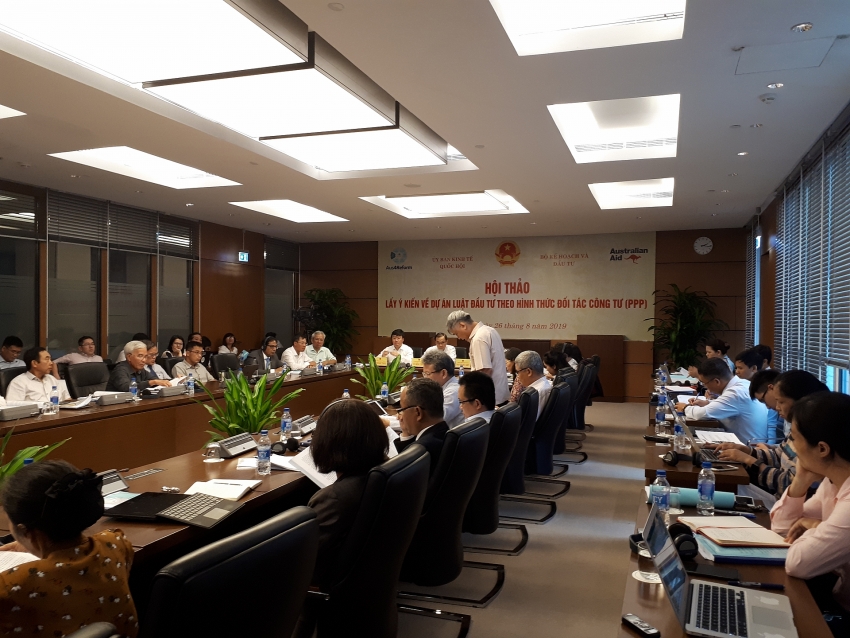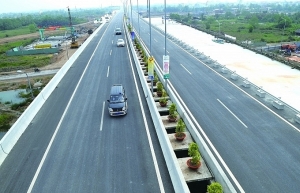Latest draft Law on PPP sees positive changes
 |
| Participants provided ample comments on the draft Law on PPP |
Businesses and experts gathered at a roundtable meeting on August 26 to discuss some key issues in the long-awaited draft law on public-private partnership (PPP) ahead of its submission to the National Assembly for discussion in October 2019.
The event held by the Ministry of Planning and Investment (MPI) and the National Assembly’s Economic Committee was chaired by Deputy Minister of Planning and Investment Nguyen Duc Chung and Vu Hong Thanh, head of the committee, with discussions focusing on the different kinds of PPP contracts, appraisal of PPP projects, the government guarantee mechanism, minimum capital requirements, and risk-sharing mechanisms, among others.
“The draft law is aimed to build bankable legal framework for PPP projects, to effectively attract private investment in PPP projects to develop the national infrastructure, to align with international commitments on investment and trade, and to deal with differences with other laws,” said Nguyen Dang Truong, head of the Public Procurement Agency (PPA) of the MPI – the committee that composed the draft.
There are several positive changes in the draft law regarding the government guarantee mechanism and risk-sharing. Specifically, the draft law proposes government guarantee of foreign exchange balance for PPP projects determined by the NA and the prime minister, with a ceiling of 30 per cent of project revenue in VND.
Also importantly, the risk-sharing mechanism for revenue is also proposed in the draft law to be extended to key projects decided by the NA and the prime minister.
Some changes in the draft law include criteria for sectors not open for PPP projects. Accordingly, PPP projects are proposed not to be made available in sectors that have so far seen no PPP projects, those having ineffective PPP projects, or those lacking appeal to investors, and others where other kinds of investment would be more fitting.
Under the draft, tourism; culture and sports; telecommunications infrastructure; infrastructure for science and technology development; infrastructure at industrial parks, economic zones, industrial clusters, and high-tech parks; and infrastructure for rural areas and agriculture are the sectors where PPP development would not be available.
In terms of minimum capital requirement, the draft law proposes a minimum of VND200 billion ($8.7 million) capitalisation for PPP projects.
Talking about the draft law, Nguyen Van Phuc, former deputy head of the NA Economic Committee, said that the composing committee should consider the limitations of the sectors open for PPP projects to ensure flexibility, efficiency, and to meet the demands of socio-economic development. He also raised concerns over the minimum capital requirement.
The international experts present at the event focused their comments on the risk-sharing mechanism with lessons from other countries.
According to a representative from EY, governments have put in place mechanisms to support and/or share risks, which has been instrumental to kick-start investment into PPP projects.
India established Viability Gap Fun (VGF) to provide financial support at the construction stage, issued clear guidelines on eligibility criteria, and clarified the disbursement mechanism for PPP projects. It also created Model Concession Agreements (MCAs) which helped standardise the concession agreements and risk allocation principles in different sectors.
Indonesia and South Korea also have mechanisms to provide guarantees for investors.
Taking a similar view, Sanjay Grover, PPP specialist from the Asian Development Bank, said that there are many countries have risk-sharing mechanisms such as Indonesia, Turkey, India, and South Korea.
“PPP-related government risk sharing is critical for Vietnam to attract private sector capital. The PPP law should allow comprehensiveness (termination, foreign exchange, minimum revenue, and others) and flexibility in risk-sharing to suit project, sector, and market situations,” said Sanjay Grover.
Vietnam has so far attracted 336 PPP projects in transport, technical infrastructure, energy, water supply and drainage, and environment, culture and sports, education and training, and other fields.
As planned, the draft Law on PPP will be completed in September 2019 before being submitted to the National Assembly for discussion in October 2019 and then for approval in May 2020.
The World Bank estimated that Vietnam will require investments of up to $25 billion annually in sustainable infrastructure.
 | Ministries muse PPP fund After years of consideration, Vietnam is seriously pondering the creation of a public-private partnership development fund in a long-awaited draft law, in line with the ... |
 | New PPP model for universal healthcare In anticipation of the growing importance of public-private partnership, Vietnam and partners are working on a new model to strengthen primary healthcare services as the ... |
 | PPP the key driver for Industry 4.0 success Aligned to the global movement towards a digital economy, Vietnam is taking the Fourth Industrial Revolution in its stride. The big question is who should ... |
What the stars mean:
★ Poor ★ ★ Promising ★★★ Good ★★★★ Very good ★★★★★ Exceptional
 Tag:
Tag:
Related Contents
Latest News
More News
- PM orders investment model for North–South high-speed rail (December 22, 2025 | 17:43)
- First members of Danang International Finance Centre revealed (December 22, 2025 | 17:39)
- Securing capital and efficiency for Vietnam’s 2026-2030 growth ambitions (December 17, 2025 | 10:00)
- Driving double-digit growth through green and circular transformation in Vietnam (December 17, 2025 | 09:00)
- Vietnam bucking trend in the global M&A landscape (December 16, 2025 | 14:20)
- Vietnam’s green transition demands collective financial action (December 15, 2025 | 12:00)
- VIR workshop highlights capital and policy for sustainable development (December 15, 2025 | 11:00)
- National Assembly approves pilot mechanisms to accelerate major projects in Hanoi (December 12, 2025 | 11:29)
- Vietnam eases policy approval requirements, simplifies foreign and outbound investments (December 11, 2025 | 17:53)
- Unpacking new momentum in Vietnam’s M&A market (December 10, 2025 | 09:59)























 Mobile Version
Mobile Version